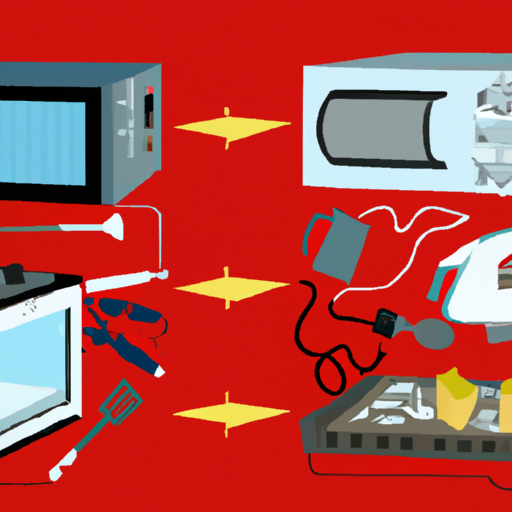In this article, you will explore the fascinating world of energy-saving appliances and discover how they stack up against their standard counterparts in terms of both cost and performance. Gain insights into the potential savings you could achieve with energy-efficient appliances and learn about the various factors that contribute to their superior performance. Whether you’re looking to upgrade your current appliances or simply curious about the benefits of energy-saving technology, this article will provide you with valuable information to make informed decisions.
Cost
Initial cost
When it comes to the cost of energy-saving appliances versus standard models, there is a slight difference in the initial cost. Energy-saving appliances tend to have a higher upfront price compared to standard models. This is because energy-saving appliances often utilize advanced and efficient technologies, which can increase manufacturing costs. However, it is important to consider the long-term cost savings that energy-saving appliances can offer.
Operating cost
While energy-saving appliances may have a higher initial cost, they prove to be more cost-effective in the long run due to their lower operating cost. Energy-saving appliances are designed to consume less electricity or water, resulting in lower utility bills. By using advanced technologies, such as sensor technology and improved insulation, these appliances are able to perform their functions efficiently without wasting resources. Over time, the operating cost savings of energy-saving appliances can outweigh the initial investment.
Long-term cost savings
One of the major advantages of energy-saving appliances is the potential for long-term cost savings. These appliances are specifically designed to minimize energy consumption and reduce wastage, resulting in significant savings on utility bills over their lifespan. Although energy-saving appliances may have a higher upfront cost, the reduced operating costs can make up for this initial investment in a relatively short period of time. In addition, energy-saving appliances often have longer lifespans and require fewer repairs, further contributing to long-term cost savings.
Energy Efficiency
Energy usage
Energy-saving appliances are specifically designed to use less energy compared to standard models. They employ advanced technologies, such as improved insulation and energy-efficient motors, to minimize energy consumption without sacrificing performance. By using less energy, these appliances not only reduce utility bills but also contribute to a greener and more sustainable environment.
Energy consumption patterns
Standard models often consume more energy due to less efficient design and outdated technologies. On the other hand, energy-saving appliances are manufactured with a focus on optimizing energy consumption patterns. These appliances may use energy more efficiently during operation or offer programmable features that allow users to schedule energy-intensive tasks during off-peak hours. By considering and adjusting energy consumption patterns, energy-saving appliances can help users reduce their environmental impact and save on energy costs.
Energy efficiency ratings
Energy-saving appliances are typically labeled with energy efficiency ratings to help consumers make informed choices. These ratings, such as the Energy Star certification, indicate the level of energy efficiency a particular appliance possesses. Higher ratings indicate greater energy efficiency, meaning that the appliance consumes less energy to perform its functions. It is advisable to look for appliances with higher energy efficiency ratings to maximize the cost and energy savings.
Performance
Power and speed
Energy-saving appliances are designed to deliver comparable power and speed to their standard counterparts, ensuring optimal performance. Manufacturers have focused on improving the efficiency of energy-saving appliances without compromising on their ability to perform the desired tasks. Whether it is a dishwasher, refrigerator, or washing machine, energy-saving models are engineered to provide the necessary power and speed required for efficient operation.
Durability and lifespan
Energy-saving appliances often boast improved durability and longer lifespans compared to standard models. The use of advanced technologies and materials in energy-saving appliances contributes to their enhanced durability, reducing the need for frequent repairs or replacements. While the initial cost may be higher, the longer lifespan of energy-saving appliances can result in significant cost savings over time.
Noise levels
Energy-saving appliances are designed to operate with minimal noise levels, ensuring a quieter living environment. Manufacturers have made extensive efforts to reduce noise in energy-saving models, incorporating noise reduction technologies and improved insulation. This not only enhances customer satisfaction but also contributes to a more peaceful and enjoyable home atmosphere.
Features and Functions
Available options
Energy-saving appliances offer a wide range of options and features to meet diverse consumer needs. Whether it is a refrigerator with adjustable temperature settings or a washing machine with different cycle options, energy-saving appliances provide a variety of functions to suit individual preferences. By offering a multitude of options, manufacturers of energy-saving appliances ensure that consumers have access to appliances that meet their specific requirements.
Smart technology integration
Energy-saving appliances often incorporate smart technology, allowing users to remotely control and monitor their appliances through mobile devices. This integration of smart technology enables users to optimize energy consumption by scheduling tasks, adjusting settings, and receiving energy usage reports. By integrating smart technology, energy-saving appliances offer convenience, flexibility, and further energy-saving opportunities for consumers.
Environmental Impact
Reduced greenhouse gas emissions
The use of energy-saving appliances significantly reduces greenhouse gas emissions and contributes to environmental conservation. By consuming less energy, these appliances decrease the reliance on fossil fuels for electricity generation, leading to a lower carbon footprint. Energy-saving appliances play a crucial role in mitigating the environmental impact and combating climate change.
Water conservation
Energy-saving appliances, particularly those used for water-related tasks, prioritize water conservation. For example, energy-saving washing machines often have sensors that adjust water levels based on the size of the load, preventing unnecessary water wastage. Dishwashers with efficient water circulation systems also reduce water consumption. By conserving water, energy-saving appliances promote sustainable usage and help preserve this valuable resource.
Waste reduction
Energy-saving appliances are designed with a goal to minimize waste generation. Manufacturers implement strategies such as using recyclable materials in their construction and developing appliances with longer lifespans. By reducing waste generation, energy-saving appliances contribute to a cleaner and more sustainable future.
Safety
Electrical safety
Energy-saving appliances undergo rigorous testing to ensure compliance with electrical safety standards. Manufacturers prioritize the safety of users by implementing insulation technologies, reliable grounding systems, and effective circuit protection mechanisms. Energy-saving appliances also adhere to safety regulations and certifications to provide consumers with peace of mind when using these appliances.
Fire hazards
Energy-saving appliances are designed and manufactured with extensive fire safety features. These appliances incorporate temperature control mechanisms, automatic shutdown systems, and optimized ventilation to prevent overheating and minimize the risk of fires. By prioritizing fire safety, energy-saving appliances offer enhanced protection and reduce the chances of accidents or property damage.
Toxicity
Energy-saving appliances are produced with a focus on minimizing the use of toxic materials. Manufacturers adhere to strict regulations, such as the Restriction of Hazardous Substances (RoHS) directive, to ensure that their appliances do not contain harmful substances. By reducing toxicity, energy-saving appliances safeguard users’ health and contribute to a safer living environment.
Government Incentives and Rebates
Tax credits
Governments and regulatory bodies often offer tax credits as incentives for purchasing energy-saving appliances. These tax credits provide financial benefits to consumers, reducing the overall cost of acquiring energy-saving appliances. By taking advantage of tax credits, consumers can further offset the initial investment required for energy-saving appliances and make them more affordable.
Rebate programs
In addition to tax credits, governments and utility companies sometimes offer rebate programs to encourage the adoption of energy-saving appliances. These rebate programs provide financial incentives to consumers who purchase energy-saving appliances, typically in the form of cash reimbursements or discounts. By participating in rebate programs, consumers can receive monetary benefits that offset the initial cost, making energy-saving appliances even more accessible.
Long-Term Benefits
Energy savings
One of the most significant long-term benefits of energy-saving appliances is the potential for substantial energy savings. By using less energy during operation, these appliances contribute to reduced utility bills over their lifespan. The energy savings from energy-saving appliances can accumulate over time, resulting in considerable cost savings for consumers. Additionally, the reduced energy consumption of these appliances benefits the environment by decreasing overall energy demand.
Reduced maintenance and repair costs
Energy-saving appliances often have longer lifespans and require fewer repairs compared to standard models. The advanced technologies and materials used in energy-saving appliances enhance their durability and reliability, minimizing the need for costly repairs or replacements. With fewer maintenance expenses, consumers can enjoy further cost savings over the lifespan of their energy-saving appliances.
Consumer Satisfaction
User reviews
Energy-saving appliances have received positive feedback from consumers, with many highlighting their long-term cost savings and energy efficiency. User reviews often praise the reliable performance, enhanced durability, and monetary benefits of energy-saving appliances. Consumers appreciate the lower utility bills and reduced environmental impact associated with using energy-saving appliances, leading to high levels of satisfaction.
Customer feedback
Customer feedback further illustrates the satisfaction and benefits experienced by users of energy-saving appliances. Many customers report significant reductions in their energy bills after switching to energy-saving models. Additionally, the improved performance, quieter operation, and advanced features of energy-saving appliances contribute to customer satisfaction. The positive customer feedback demonstrates the effectiveness and appeal of energy-saving appliances.
Considerations Before Purchasing
Fit for specific needs
Before purchasing an energy-saving appliance, it is crucial to consider whether it suits your specific needs. Evaluate the functions, capacity, and features required for your household or business. Energy-saving appliances come in various sizes and configurations, ensuring that you can find one that fits your specific requirements.
Compatibility with existing appliances
When considering energy-saving appliances, take into account the compatibility with your existing appliances. Ensure that the new appliance can seamlessly integrate with your current setup and infrastructure. Compatibility can play a significant role in maximizing the efficiency and benefits of energy-saving appliances.
In conclusion, energy-saving appliances offer several advantages over standard models when it comes to cost and performance. While they may have a higher initial cost, energy-saving appliances provide long-term cost savings through reduced operating expenses. They offer comparable power and speed, enhanced durability, and quieter operation. Energy-saving appliances also provide additional features and functions to cater to individual needs, such as smart technology integration. Furthermore, these appliances have a positive environmental impact, contributing to reduced greenhouse gas emissions, water conservation, and waste reduction. Safety is a priority for energy-saving appliances, ensuring electrical safety, minimizing fire hazards, and reducing toxicity. Governments offer incentives such as tax credits and rebate programs to encourage the adoption of energy-saving appliances. The long-term benefits of energy savings and reduced maintenance costs are significant advantages. Consumer satisfaction is high, as evident from positive user reviews and feedback. Considering specific needs and compatibility is key before purchasing energy-saving appliances. Ultimately, energy-saving appliances prove to be a beneficial investment for cost savings, performance, and sustainability.


